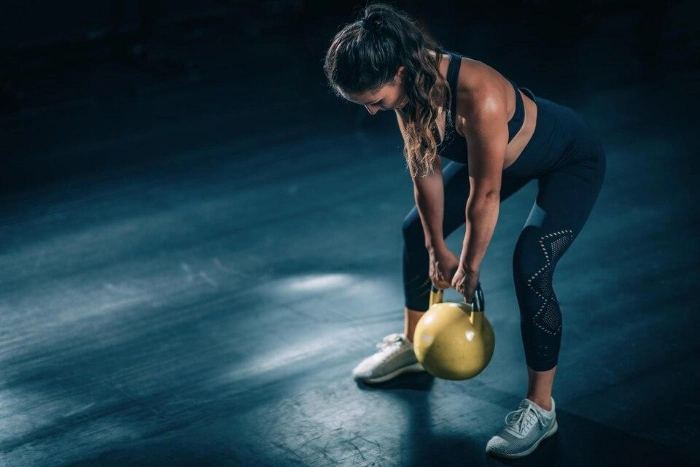Kettlebell Exercises For Better Posture

-
Learning The Value Of Good Posture
-
Core Strengthening Kettlebell Exercises
-
Enhancing Posture With Kettlebell Swings
-
Kettlebell Rows Build Upper Back Strength
-
Shoulder Stability Kettlebell Halo
-
Kettlebell Lunge Variations For Lower Body Alignment
-
Kettlebell Windmills Improve Spinal Mobility
-
Different Kettlebell Planks For Core Stability
Learning The Value Of Good Posture
Good posture affects health and beauty. Poor posture may cause back discomfort, muscular imbalances, and digestive disorders. Today's sedentary environment, when many spend hours bent over computers or smartphones, makes posture correction more critical than ever.
Targeted exercise may help overcome the posture-damaging impacts of contemporary life. Dynamic and functional kettlebell workouts improve posture uniquely and powerfully. Kettlebell exercises strengthen the core, align the spine, and increase body awareness by working with different muscle groups.
Core Strengthening Kettlebell Exercises
Core muscles are crucial to posture. Stronger abdominal, lower back and hip muscles may help you stand up straight. These core muscles may be functionally and dynamically targeted with kettlebell movements.
A good workout is the kettlebell deadlift. This activity strengthens the lower back and hips and teaches good lifting mechanics for daily life. The Turkish Get-Up is another vigorous kettlebell workout that builds core stability and balance via controlled movements.
Enhancing Posture With Kettlebell Swings
A basic workout, kettlebell swings may improve your posture. This dynamic activity builds an intense lower back and posterior chain, including the hamstrings and glutes.
Start with a hip-width stance and both hands on the kettlebell to swing. Let the kettlebell swing between your knees, then pull your hips forward to swing it to chest height. Momentum from this action engages spine muscles and maintains a neutral posture.
Exercise with kettlebell swings increases posture, cardiovascular fitness, and strength. As with any workout, start with a weight that challenges yet permits perfect technique. To maintain advantages, gradually increase weight as strength and technique improve.
Addressing improper posture is essential to good health, not just beauty. By exercising numerous muscle groups and building functional strength, kettlebell workouts enhance posture holistically. Adding these exercises to your workout may improve your posture, balance, and health.
Kettlebell Rows Build Upper Back Strength
Many people concentrate on frontal muscles while improving posture; ignoring the upper back may cause imbalances. Kettlebell rows work the muscles between the shoulder blades, counteracting slouching's forward rounding.
Begin the kettlebell row with one knee and hand on a bench while the other foot is on the floor. Hold the kettlebell in the other hand straight below your shoulder. Pull the kettlebell to your hip with your elbow close to your torso to engage upper back muscles. Strengthening the rhomboids and trapezius and promoting scapular retraction opens and uprights the chest.
Kettlebell rows strengthen the upper back and complement core and lower back exercises, generating a more balanced and supporting musculature for better posture.
Shoulder Stability Kettlebell Halo
Shoulder stability is essential to proper posture but frequently needs to be considered. Dynamic kettlebell halo exercises stabilize and prevent shoulder forward drooping by targeting shoulder muscles.
The kettlebell halo is performed with feet shoulder-width apart and hands at chest height, grasping the kettlebell by the horns. Circulate the kettlebell around your head while engaging your core. This exercise stresses the shoulder and upper back, stabilizing muscles, encouraging alignment, and minimizing rounded shoulders.
Add the kettlebell halo to your program to improve shoulder stability and posture by opening and lifting the chest. Start with a moderate weight and concentrate on controlled motions to maximize shoulder and upper back benefits with any workout.
Kettlebell Lunge Variations For Lower Body Alignment
Maintaining An Upright Posture Requires Lower Body Alignment. Kettlebell Lunge Variants Work Leg Muscles And Coordinate The Lower Body.
Kettlebell reverse lunges work the quadriceps, hamstrings, and glutes. This exercise works the lower body and straightens the spine. Lateral lunges with a kettlebell may correct hip and thigh abnormalities, making the lower body more balanced.
Adding kettlebell lunge variants to your exercise will help you develop lower body muscles and improve spine alignment and supporting posture. Concentrate on form and gradually build intensity with any workout for optimum results.
Kettlebell Windmills Improve Spinal Mobility
Spinal Mobility Is Essential For Optimal Posture. A Dynamic Workout, Kettlebell Windmills Engage Core Muscles And Improve Spine Flexibility.
Start with a kettlebell in one hand and feet wider than shoulder-width apart to do the kettlebell windmill. Raise the kettlebell overhead with a straight arm and twist at the hips to drop your body to the other foot. This action involves the obliques and erector spinae, avoiding stiffness and improving flexibility.
Kettlebell windmills increase the range of motion and flexibility, improving spinal mobility. As you do this exercise, your upright posture will improve, particularly while twisting and turning.
Different Kettlebell Planks For Core Stability
Good Posture Requires A Firm Core, And Kettlebell Plank Variants Are A Complex But Practical Approach To Building These Muscles.
Starting with a plank is fantastic, but adding a kettlebell provides variety. Start in a plank posture with two kettlebells slightly wider than shoulder-width apart and alternately draw them to the other side. This motion works the core shoulder and back stabilizers.
Kettlebell planks with shoulder taps work, too. While keeping a solid core, touch one hand on the opposing shoulder in the plank. The kettlebell's instability challenges the core muscles, strengthening and stabilizing the torso.
Adding these kettlebell plank variations to your exercise can improve core stability and posture. Start with the appropriate technique and gradually raise the difficulty of any workout to enhance your core muscles and posture.
-
Learning The Value Of Good Posture
-
Core Strengthening Kettlebell Exercises
-
Enhancing Posture With Kettlebell Swings
-
Kettlebell Rows Build Upper Back Strength
-
Shoulder Stability Kettlebell Halo
-
Kettlebell Lunge Variations For Lower Body Alignment
-
Kettlebell Windmills Improve Spinal Mobility
-
Different Kettlebell Planks For Core Stability

